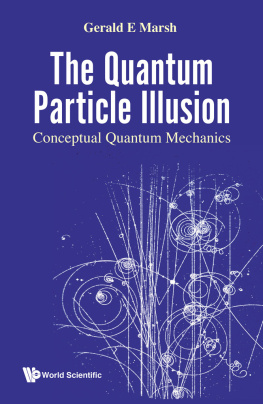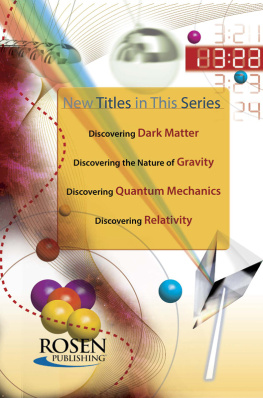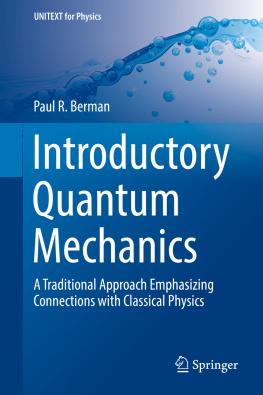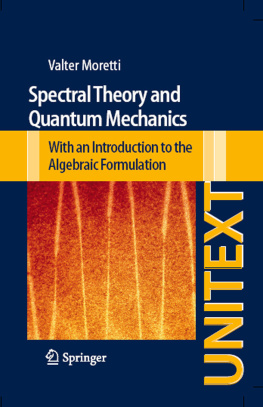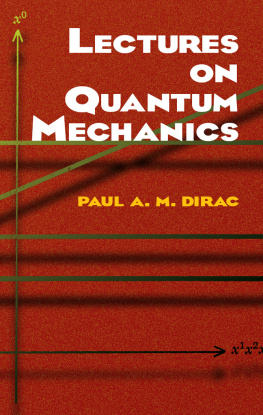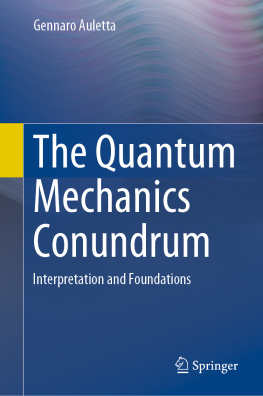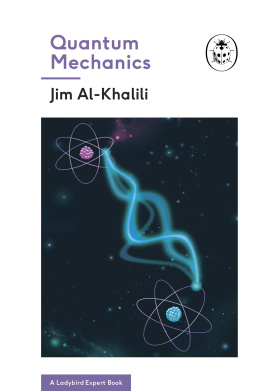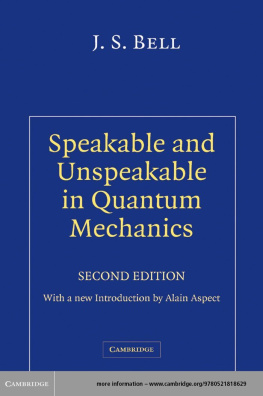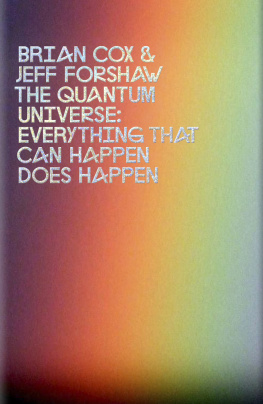The Quantum
Particle Illusion
Conceptual Quantum Mechanics
The Quantum
Particle Illusion
Conceptual Quantum Mechanics
Gerald E Marsh

Published by
World Scientific Publishing Co. Pte. Ltd.
5 Toh Tuck Link, Singapore 596224
USA office: 27 Warren Street, Suite 401-402, Hackensack, NJ 07601
UK office: 57 Shelton Street, Covent Garden, London WC2H 9HE
Library of Congress Control Number: 2021049382
British Library Cataloguing-in-Publication Data
A catalogue record for this book is available from the British Library.
THE QUANTUM PARTICLE ILLUSION
Conceptual Quantum Mechanics
Copyright 2022 by World Scientific Publishing Co. Pte. Ltd.
All rights reserved. This book, or parts thereof, may not be reproduced in any form or by any means, electronic or mechanical, including photocopying, recording or any information storage and retrieval system now known or to be invented, without written permission from the publisher.
For photocopying of material in this volume, please pay a copying fee through the Copyright Clearance Center, Inc., 222 Rosewood Drive, Danvers, MA 01923, USA. In this case permission to photocopy is not required from the publisher.
ISBN 978-981-124-822-1 (hardcover)
ISBN 978-981-124-823-8 (ebook for institutions)
ISBN 978-981-124-824-5 (ebook for individuals)
For any available supplementary material, please visit
https://www.worldscientific.com/worldscibooks/10.1142/12583#t=suppl
Printed in Singapore
This book is dedicated to my wife Evelyn without whom I would not and could not be who I am today. We married very early and had the privilege of traveling together through the harmony of life.
Preface
The topic of the foundations of quantum mechanics has a vast and very interesting literature and a great many papers and books have been written about the difficulties of interpreting quantum mechanics, in general, and the wavefunction, in particular. I will not make any attempt to review this literature since it stands on its own. One of the relatively most active modern periods was in the 1960s and 1970s and especially from 1973 to around 1979.
Quantum mechanics can only present the probability of a particle being found in any given region of spacetime. This raises the question of whether the position of a discrete particle can in principle only be predicted statistically by quantum mechanics or, whether the formalism of quantum mechanics applies not to a single particle, but rather to an ensemble of identical systems. The various approaches to interpreting the mathematics of quantum mechanics are motivated by somehow attempting to maintain our ideas about a classical particle in the context of the quantum world as found in nature.
This has led to great confusion not only among those approaching quantum mechanics for the first time, but also for those who have used the formalism to perform highly successful calculations for many years. In the end, it is the historical approach to the teaching of quantum mechanics that could be the root of the problem. Those brave enough to try and understand the conceptual foundations of quantum mechanics when being taught from this perspective, and often discouraged from doing so by the apocryphal advice given by many physicists to ignore the issue and just calculate, are generally left in a state of cognitive dissidence well expressed by the adaptation of a cartoon drawn by an anonymous artist that appeared, in a completely different context, in a government sponsored report from the mid-1980s, shown below.
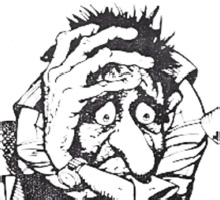
A poor soul who tries to understand the foundations of quantum mechanics after being taught the subject using an historical approach.
It is hoped that this book can relieve some of the dismay, frustration, and confusion so well expressed by this cartoon.
Gerald E. Marsh
Contents
Introduction
The statistical interpretation of the wavefunction, , is due to Max Born who, in his 1954 Nobel prize acceptance speech, ascribed his inspiration for the statistical interpretation to an idea of Einsteins. Here is the relevant quote from Borns speech: He had tried to make the duality of particles light quanta or photons and waves comprehensible by interpreting the square of the optical wave amplitudes as probability density for the occurrence of photons. This concept could at once be carried over to the -function: ||2 ought to represent the probability density for electrons (or other particles).
Einstein, in a December 1926 letter to Max Born, speaking of the secret of the Old One, said that he was convinced that He does not throw dice. And when Philipp Franck pointed out to Einstein, around 1932, that he was responsible for the idea because of papers he published during his annus mirabilis in 1905, Einstein responded that Yes, I may have started it, but I regarded these ideas as temporary. I never thought that others would take them so much more seriously than I did. Later, Einstein put it this way to James Franck: I can, if the worse comes to the worst, still realize that the Good Lord may have created a world in which there are no natural laws. In short, a chaos. But that there should be statistical laws with definite solutions, i.e. laws which compel the Good Lord to throw the dice in each individual case, I find highly disagreeable.
Einstein was not alone in being uncomfortable with the statistical nature of quantum mechanics and since then the vast literature that has appeared on the foundations of quantum mechanics was driven at least in part by an attempt to come to terms with the unusual and counterintuitive features inherent in the subject.
There were many attempts in the past to find hidden variables to avoid the statistical interpretation of the wavefunction, and there was even an informal monthly set of briefs called the Epistemological Letters put out by the Association F. Gonset or Institut de la Methode, which was distributed to, and contained theoretical correspondence from, some 100 prominent people in the field. In particular there was much discussion of Bells theorem,
| Tout le monde cherche les variables caches | Everyone is looking for the hidden variables |
| Hlas, avec quel insuccs! | Alas, with what failure! |
| Elles sont timides, elles sont petites, | They are shy, they are small, |
| De courte dure, toujours en fuite. | Short lived, always on the run. |
| Elles sont partout en dguisement, | They are everywhere in disguise, |
| Empruntant bien des vtements | Borrowing many clothes |
| Aux particules lmentaires. | Elementary particles. |
| Pour dcider ce qu'on doit faire, | To decide what to do |
| Une assemble de quarante mille | An assembly of forty thousand |
| Savants se tient Clesteville. | Savants is held in Clesteville. |
| Haute nergie! Rataxs crie, | High energy! Rataxs cries out, |
| Pour pntrer le dernier nid | To penetrate the last nest |

